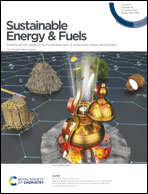Simultaneous assistance of molecular oxygen and mesoporous SO3H–alumina for a selective conversion of biomass-derived furfural to γ-valerolactone without an external addition of H2†
Abstract
The selective conversion of biomass-derived furfural (FF) into γ-valerolactone (GVL) without H2 consumption is highly interesting due to its explicit utilization as a bio-fuel additive. In this research, we focused on the synthesis of the GVL product via simultaneous integration of molecular oxygen and mesoporous SO3H–alumina catalyst in the presence of 2-butanol as a hydrogen donor. The catalyst was characterized on its chemical–physical properties in order to support catalytic test results. The critical roles of Brønsted–Lewis acid sites in the S–A catalyst, salt addition, ultrasonic irradiation, O2 and N2 existences and alcohol solvent as well as kinetic reactions were systematically investigated. As desired using S–A at an L/B ratio = 0.23, a high yield of GVL (85.6%) was achieved without sustainable formation of humins by the integration of MPV transfer hydrogenation–alcoholysis with in situ oxidative degradation. Moreover, the catalyst could be reused for up to twenty runs under oxygen conditions without significant change in its catalytic performance. This work provided a novel strategy for the sustainable production of GVL and the preservation of catalyst reusability.



 Please wait while we load your content...
Please wait while we load your content...